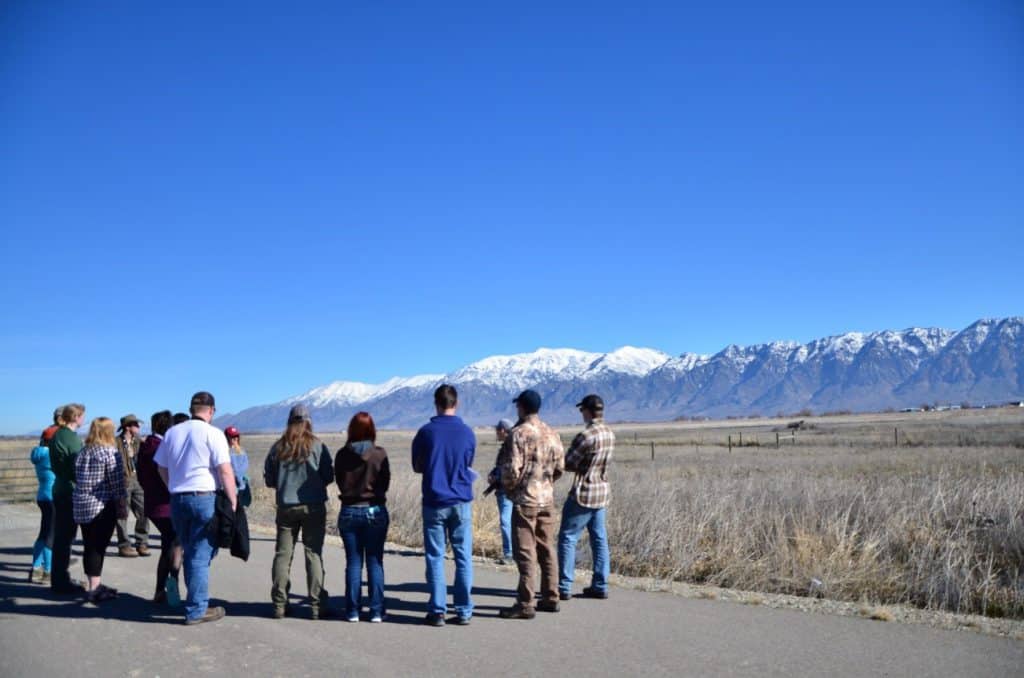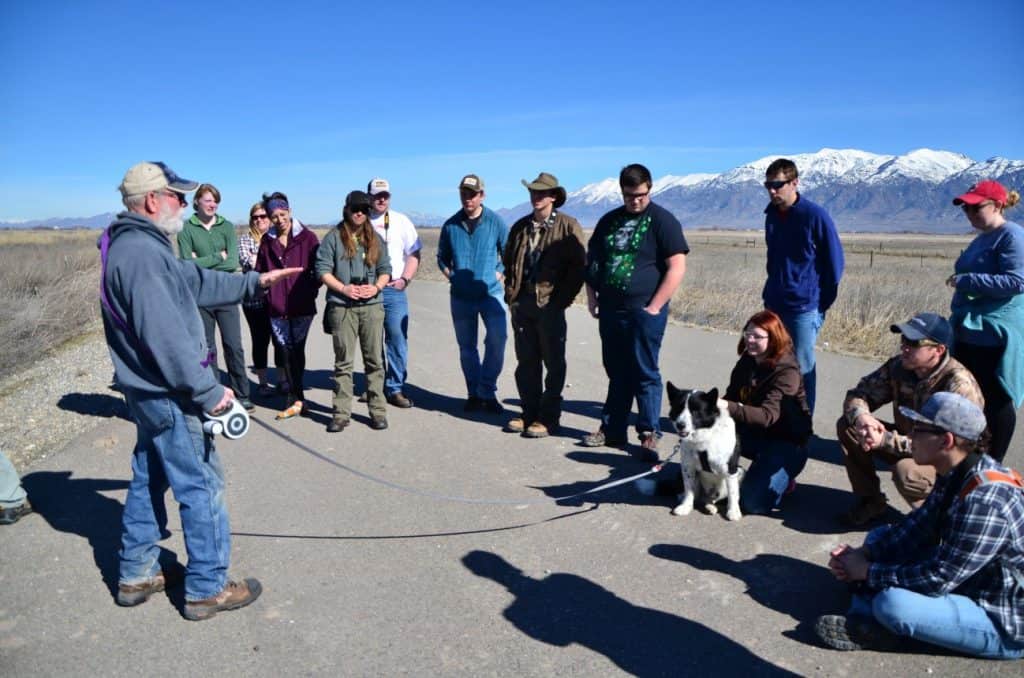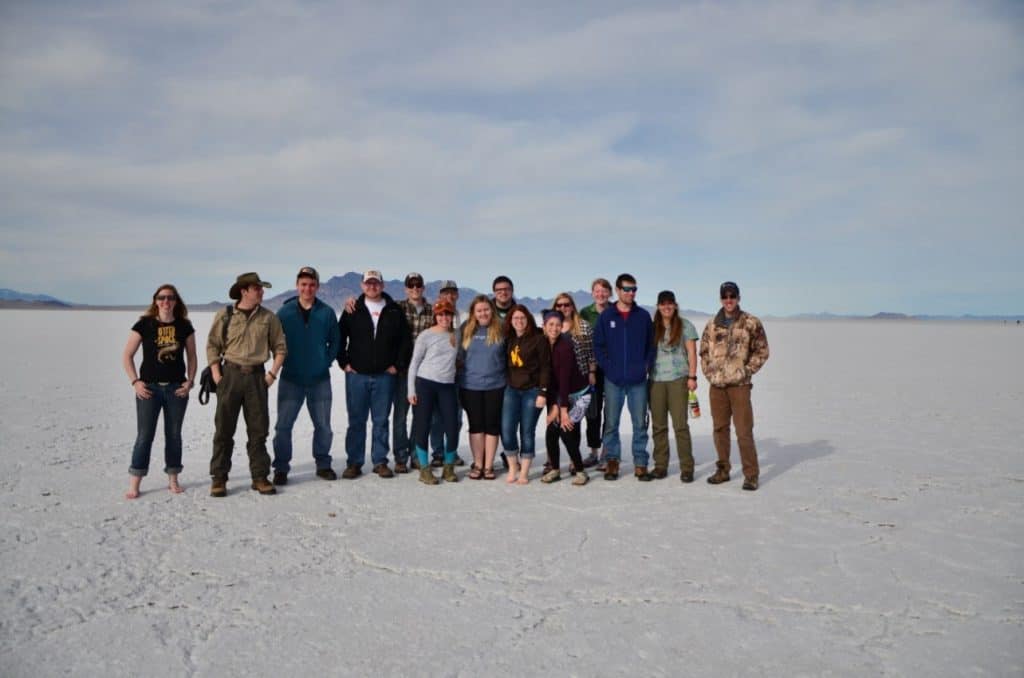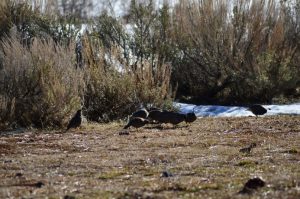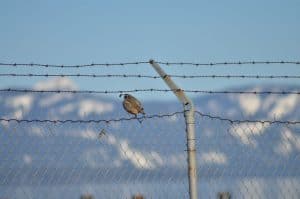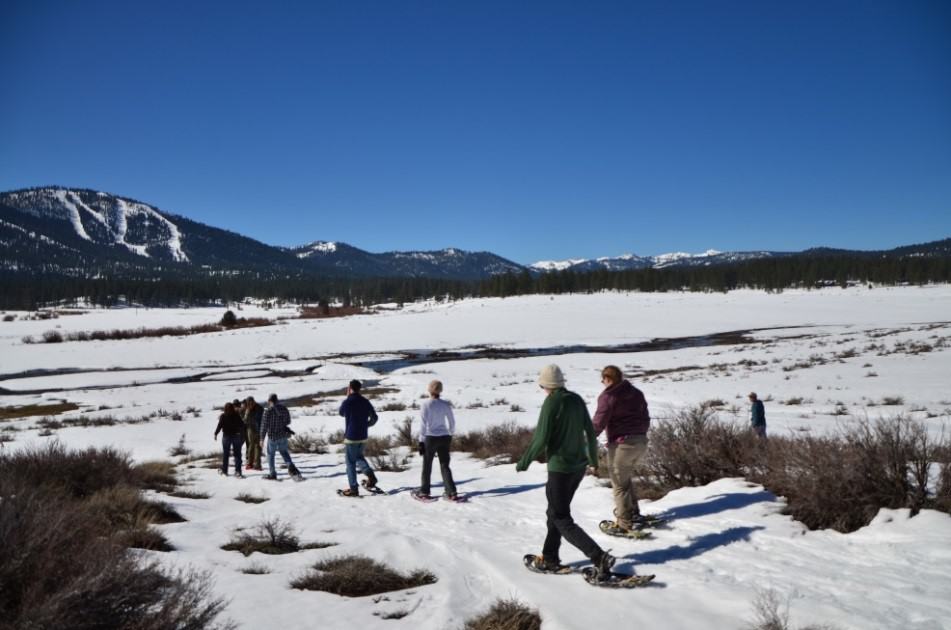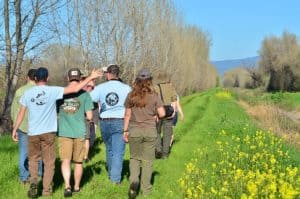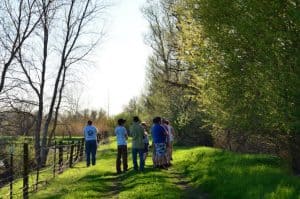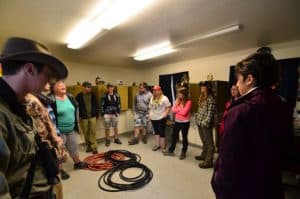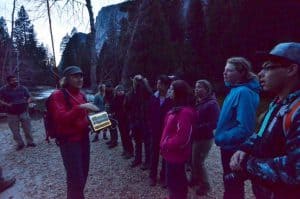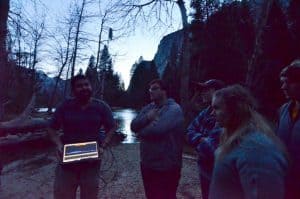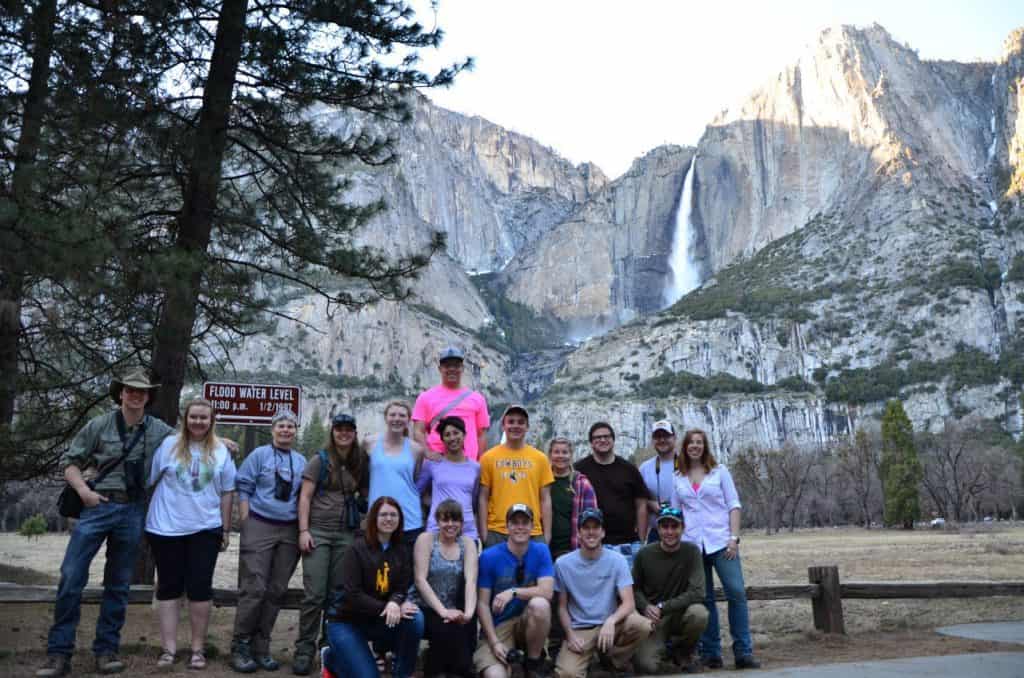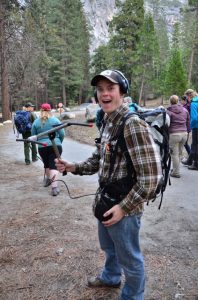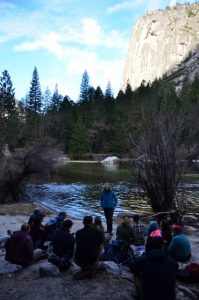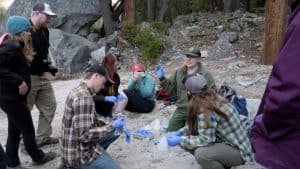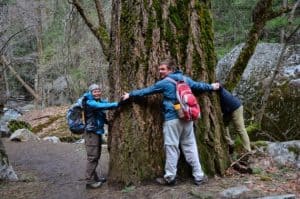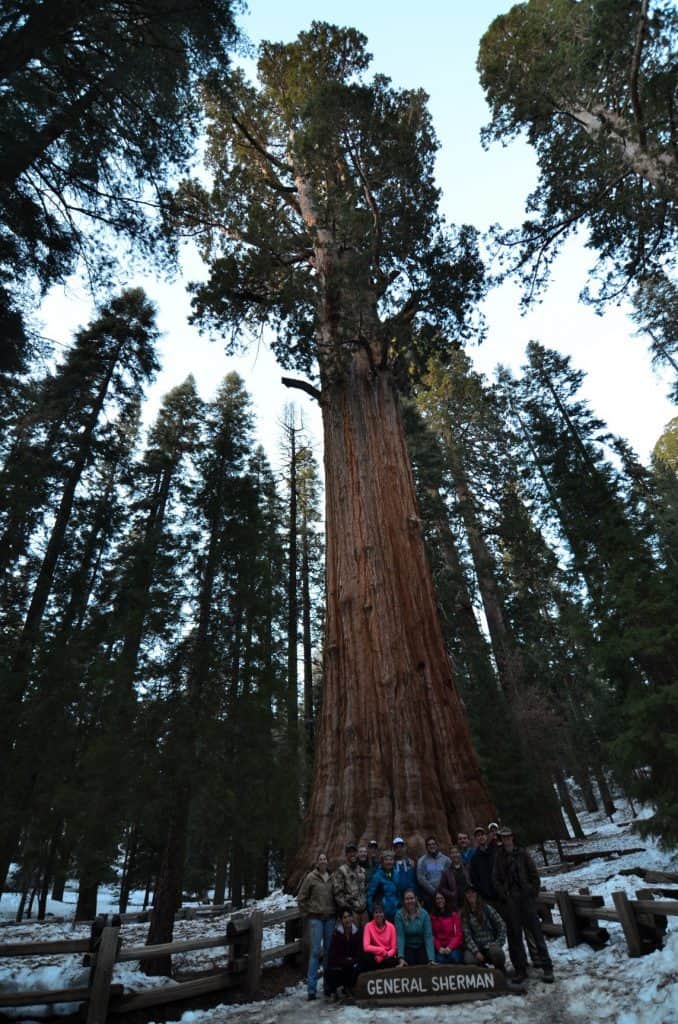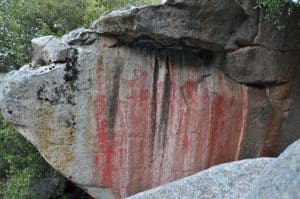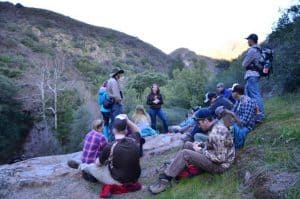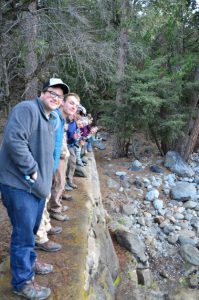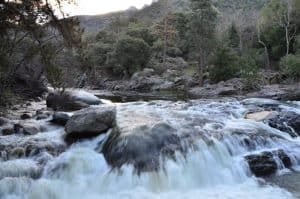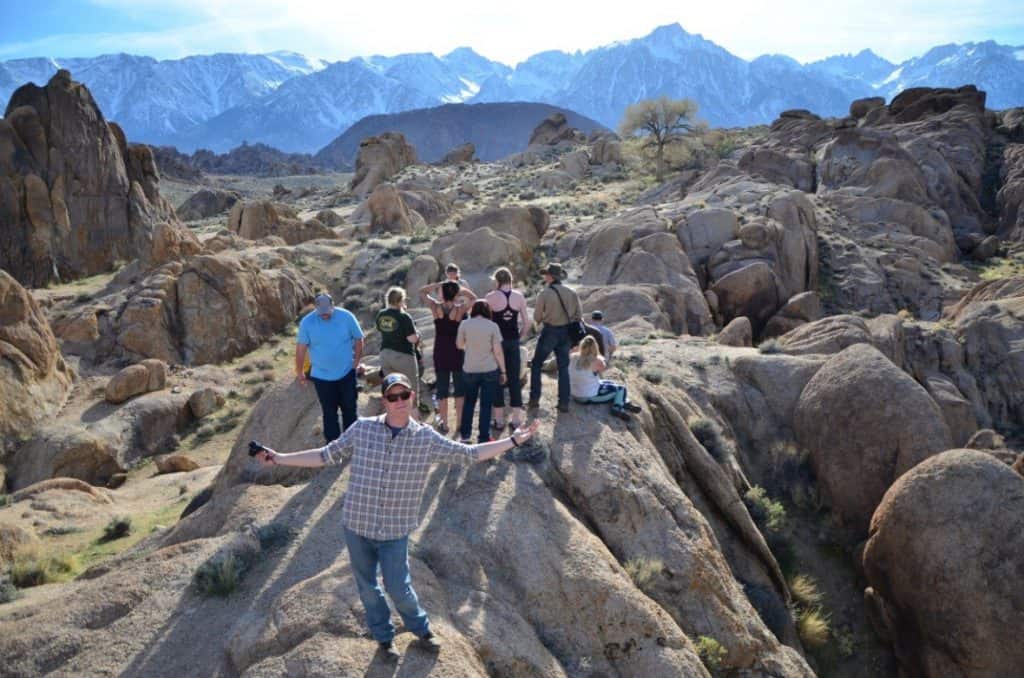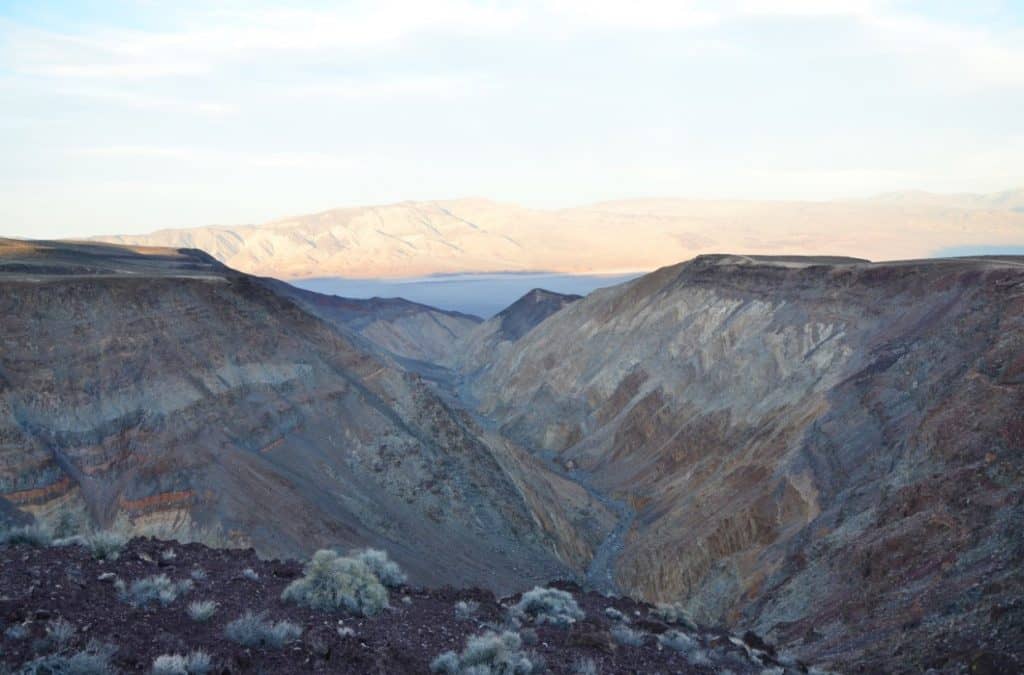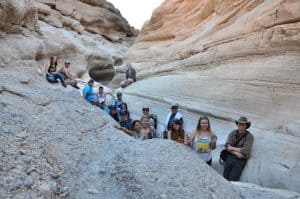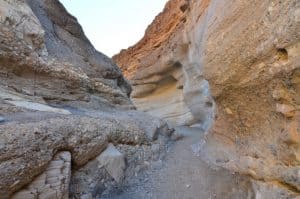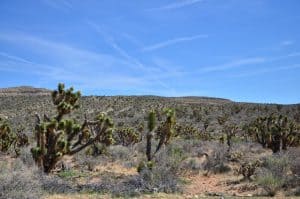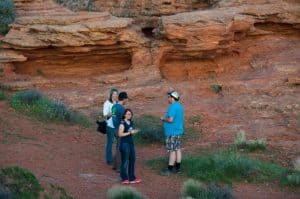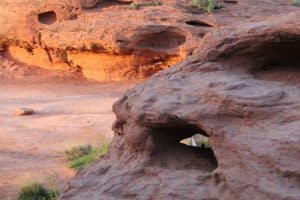University of Wyoming – TWS Western Ecosystems Trip Report
Department of Zoology and Physiology
University of Wyoming Student Chapter of the Wildlife Society
May 16, 2017
Thank you for supporting the University of Wyoming Student Chapter (UW) of The Wildlife Society during our 11th Western Ecosystems field course. This year we traveled through Utah, Nevada, and California with the goal of visiting Yosemite National Park.
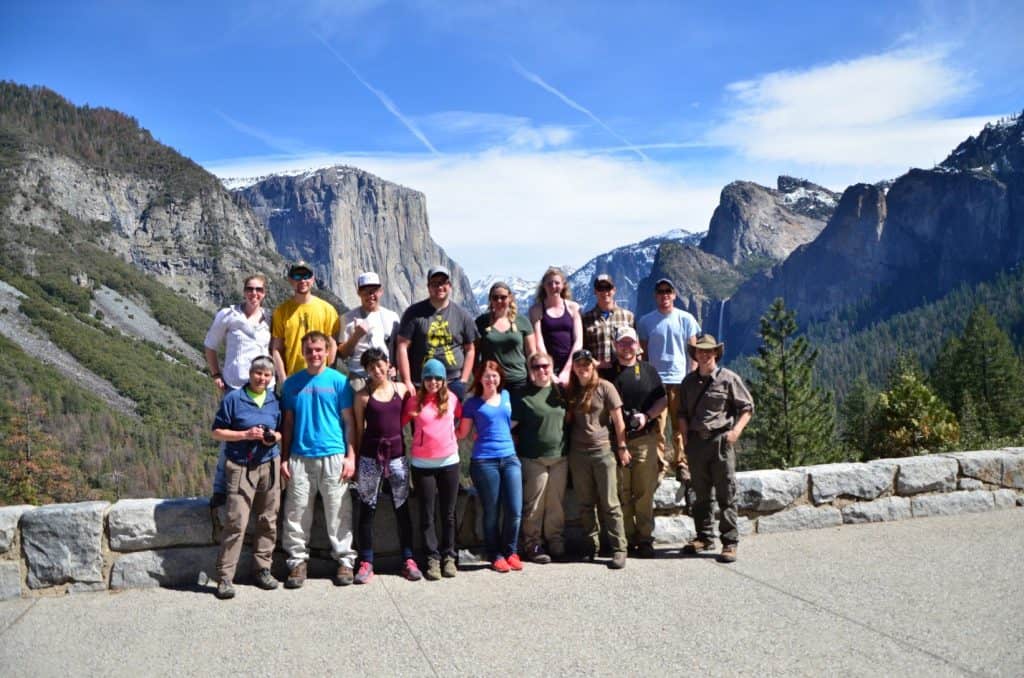
The UW TWS 2017 Western Ecosystem participants in Yosemite National Park. Standing above from top left: Kristina Harkins (our TA), Sam Sommers, Jahshua Sanchez, Tim Uttenhove, Mary Grace Bedwell, Zoe Sherman, Trevor Thorvaldson (our VP), and Grant Greenman. Bottom row from right: Colton Hoffer, Ben Tjekpes, Brittany Wagler (our president), Olivia Terry, Ivy Engel, Alex Viara, Erin Jensik, Andy Walker, and Merav Ben-David (our advisor).
The UW TWS 2017 Western Ecosystem participants in Yosemite National Park. Standing above from top left: Kristina Harkins (our TA), Sam Sommers, Jahshua Sanchez, Tim Uttenhove, Mary Grace Bedwell, Zoe Sherman, Trevor Thorvaldson (our VP), and Grant Greenman. Bottom row from right: Colton Hoffer, Ben Tjekpes, Brittany Wagler (our president), Olivia Terry, Ivy Engel, Alex Viara, Erin Jensik, Andy Walker, and Merav Ben-David (our advisor).
We started our trip on Friday (March 10) and drove directly to Evanston, Wyoming. The Uinta County School District #1 kindly allowed us to stay in the Evanston High School Wrestling Room (how odd to crash on those very soft mats!). We thank Superintendent Ryan Thomas, Cheri Dunford (Administrative Assistant for Superintendent), and Pat Rooney for the kind hospitality.
Early the next morning we drove to the Bear River Migratory Bird Refuge north of Salt Lake City only to find out the Refuge roads were closed due to flooding. So we walked instead of driving through. Our first presentation of the trip was on “The National Wildlife Refuge System – Mission, History, and Success” from Jahshua Sanchez.
At the Refuge we met Akela, the Karelian bear dog and his handler Tim Cavey who drove up to meet us from Salt Lake City. Tim shared his bear stories with us and explained the use of Karelian dogs in bear management in North America. It was hard to say who enjoyed the encounter more: the students or Akela, who received a ton of attention.
From Bear River Migratory Bird Refuge we continued west to the Humboldt-Toiyabe National Forest Austin Ranger District in Nevada. On the way we stopped at the Great Salt Lake and enjoyed walking on the crust. The weather was incredible!
In Austin, Nevada, we spent the night at the local school. Our gracious host, Debbie Bispo, explained that the area has suffered population decline due to an economic downturn. According to Debbie, there are very few students currently attending the school. It was interesting and disheartening to learn about the decline of rural communities in the West.
Early the next morning we met with Marcus Blum, a PhD student at the University of Nevada, Reno, who is studying bighorn sheep on Lone Mountain near Tonopah. Here we heard from Ben Tjekpes on “Restoration of the Sierra Nevada bighorn sheep.” Marcus Blum and his technicians added to Ben’s presentation from their personal experiences. It was a great opportunity to learn from people involved in research and translocation efforts. The sheep were a bit skittish so we only saw them from afar despite climbing up a steep “escape terrain” mountain slope. One of the coolest observations that day was a “frozen in place” jackrabbit.
From Lone Mountain we drove “the loneliest road in the continental US” to Reno where we had a pizza dinner with members of the University of Nevada Student Chapter of The Wildlife Society. We spent the night at Nevada 4-H Camp at Lake Tahoe. Again, not enough words to thank the 4-H people and especially Carrie Stock and Kent Worker for their kindness. Lake Tahoe was beautiful the next morning!
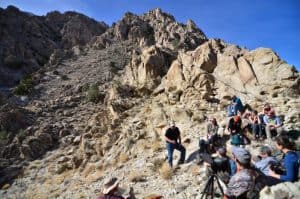
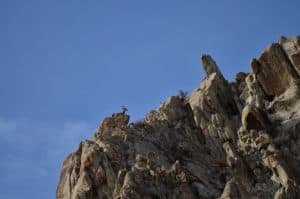
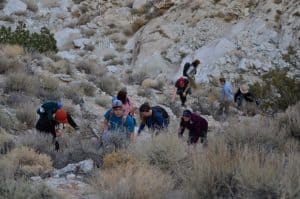
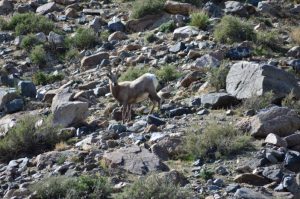
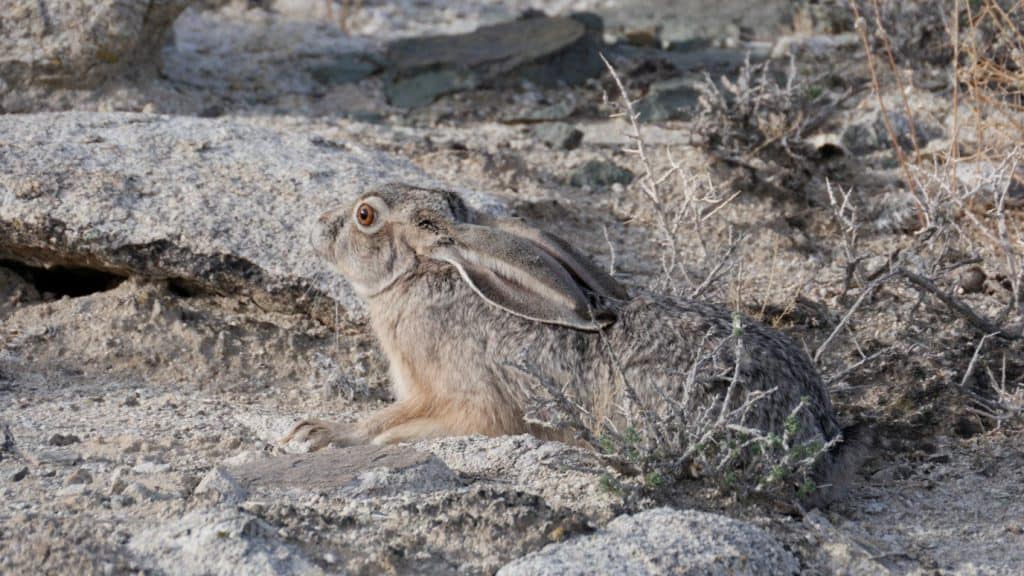
While overlooking the lake Sam Sommers told us about “Multiple use management in the Humboldt-Toyiabe National Forest.” It was hard to stay focused on the talk because a small flock of California Quails was bobbing around the bushes behind us.
From Lake Tahoe we drove northwest to the central valley of California. It was a beautiful drive! On the way we stopped at a snowy valley on the Nevada-California state line and took advantage of the snowshoes we borrowed from WyCHEG (thanks ET!). For some this was a first experience with this traveling mode! We even held a race. Guess who won?
We arrived at Rancho Esquon in the late afternoon and went for a hike around the restored wetlands. Rancho Esquon is one of the ranches in the area that converted rice fields back to wetlands. The goal is to recover some of the waterfowl habitat that was lost when the central valley was converted to intense agriculture. Unfortunately, because of the recent flooding in California the ponds were drained to provide relief for the vegetation which meant that we saw only few ducks and other wetland species.
That evening Grant Greenman told us all he learned about “Waterfowl habitat restoration in the central valley of California,” and the next morning we visited the Ranch’s duck incubation facility. When agricultural activities disturb duck nests the farmers and ranchers bring the eggs to Rancho Esquon where they are incubated and the ducklings are raised. Then these animals are released across the central valley in restored wetlands. Many thanks to Rick Ponciano and Loretta Gardiner for hosting us!
The next morning we left Rancho Esquon on our way to Yosemite National Park. On the way we stopped at the Oroville Dam hoping to see the damage that was caused to its spillway during the floods in February. Unfortunately the area was closed and we were only able to see the reservoir above the dam from the visitor center. Apparently the dam’s spillway is still under repairs today. This detour caused us to arrive at Yosemite later than planned and we missed meeting the Park’s bear biologists. But we were lucky to connect with Sarah Stock (terrestrial wildlife ecologist), Lisa Murphy (interpreter naturalist), and Sam Aguilar (wildlife intern) who took us on a short walk at dusk to look for bats. In Yosemite they are testing a new system to recognize bats from their ultrasonic call in real time. It was amazing to see the sonograms on the screen at the same time the bats were flying overhead.
It was very interesting to learn what these biologists do on a daily basis, how they are funded, and what prospects there are for biologists looking to work for the Park Service. Mary Grace Bedwell’s talk that evening on “John Muir and the foundation of Yosemite National Park” was fantastic! And of course the Yosemite Valley was as magnificent as we expected.
The next morning we went for a hike with the Park’s aquatic biologist, Colleen Kamoroff. On the way to one of the few sites where the endangered California red-legged frogs were re-introduced, Trevor Thorvaldson tracked one of the western pond turtles that were released into the Yosemite Valley. At the site we helped Colleen collect water samples for eDNA analysis. At the pool’s edge Zoe Sherman told us about “The Joseph Grinnell survey and re-survey of Yosemite National Park.” An amazing conservation story! Another wonderful presentation followed later that night at our AirBnB accommodation. Andy Walker (a freshman!) presented a talk on “Pacific fishers – ecology, distribution and conservation efforts.”
We could have easily spent more time in Yosemite but had to race south to Sequoia National Park. It was a long drive because the direct roads between the two parks were closed due to landslides, so we arrived late (again). We raced up the mountain before it got dark to catch sight of the giant sequoias. With every twist in the curvy road the temperature dropped so by the time we got to the top it was really cold. Not much to say – it was a breathtaking experience! And Brittany Wagler’s presentation on “The evolution and ecology of Sequoia forests” was award winning (she did get the top score from all of us).
Brittany’s main competition for first place in presentation quality was Colton Hoffer who told us about “Sequoia and Kings Canyon National Parks – Globally Important Bird Areas; why?” This was after the one and only dinner on the trip which was NOT cooked by Kristina!
The next morning after a short walk in one of the canyons and an excellent talk by Ivy Engel on “Amphibian declines in North America – causes and conservation efforts,” we met with the two park biologists Danny Gammons (Terrestrial – bears) and Danny Bioano (Aquatic). The Dannys told us about their jobs and their career paths and answered many(!) questions. We really appreciate their willingness to spend so much time with us. At the small gift shop in Sequoia we found our trip mascot – Sherman the bat.
Again we hit the road later than planned and got stuck in traffic around Bakersfield. So of course we were late (again!) for our meeting with Jonathan Fusaro from the California Department of Fish and Game who waited for us (very patiently) at Lone Pine. Jonathan took us to Alabama Hills, the site of the early Hollywood western movies, and told us about his job and career path under the looming tallest peak in the 48 states, Mt. Whitney.
We got a little exercise running on the boulders and then listened to Alex Vaira’s talk on “Wild pigs and mountain lions in California.”
And then onward to Death Valley! What a beautiful place!
After getting a bit lost searching for our accommodations in Pahrump (which was in the middle of nowhere!) we finally crashed for the night. The next morning we hiked parts of Mosaic Canyon where Olivia Terry explained “The geology of Death Valley.” Who would have thought that wildlife students will be so fascinated by a talk about geology? It helps when it comes from an emerging expert……
And then we started the long drive back. First, we stopped at Red Rock Canyon Natural Conservation Area outside of Las Vegas and spent time touring the interactive visitor center. We were hoping to see the desert tortoises but they were still in hibernation. So we had to be satisfied with flowering Joshua trees. At the amphitheater Erin Jensik told us about “Feral horse management in Nevada” although unfortunately the actual animals were out of sight in one of the canyons. Kathleen Sorom, Kelsey Retich from the BLM and one of their colleagues were kind to show us around and tell us about their jobs.
From Las Vegas we drove to St. George where we met Mike Schijf from the Red Cliffs Desert Reserve. Mike explained the origin of the reserve and how he deals with the multiple stakeholders involved in the project. It was fascinating to learn how collaboration among unlikely partners can lead to great conservation efforts. After a short romp on the cliffs we headed to the Shepherd on the Hill Methodist Church where we spent the night. The hospitality of Sandi Marler is highly appreciated!
We returned home late on Saturday (March 18) after a long day of driving. What a whirlwind of a trip!
And a few of our impressions:
“The western ecosystems course allowed me to experience things that I have never experienced before and gave me new insight into the wildlife field. Being able to talk with biologists and graduate students allowed me to consider where I wanted to take my career. Getting to see new species of wildlife was definitely the highlight of the trip especially all the bird species that were new to me. Some of my highlights from birding were the California Quail near Lake Tahoe, the Great Egret, Black Phoebe, Golden-crowned Sparrows, and Yellow-billed Magpies along with so many others at Rancho Esquon, and Acorn Woodpeckers at Yosemite National Park. I learned so much throughout the whole trip and was exposed to so many different wildlife management practices. I particularly enjoyed hiking in the desert of Nevada to find desert bighorn sheep, using microphones to detect bat frequencies in Yosemite, and using a telemetry unit to pick up signals from western pond turtles. This trip also allowed me to make new friends and having geologist majors along gave us new insight into much of the geology of different areas along trip. I also have to note how awesome it was to get to view scenery such as Yosemite falls, El Capitan, the giant sequoias, and Death Valley. I learned so much on this trip and I would suggest this course for anyone especially those in the wildlife major.” – Colton Hoffer
“The Western Ecosystems trip we went on for Spring Break was one of the best times I had this year. Not knowing anybody else who was on it, I Initially had second thoughts about it. But after a week spent in a car with everyone, I got to know them as friends. It was awesome that we had the opportunity to see so many places and meet with so many experienced professionals. I had never been west of Salt Lake before, so getting to travel to all these places for the first time made it even better. I’m also proud of myself with how my presentation went. I researched extensively for it, and was honestly nervous about how it would be received because I knew very little of the expectations. That being said, I’m really appreciative of the compliments I got on it. I did like the whole idea of the fragmented presentations throughout the trip. It made it so that we forgot we were on a class trip, and they were given at relevant times and usually pretty interesting. Although Yosemite was breathtaking, I would have to say my favorite place or moment on the trip was the drive up to see the Sequoias. The mountains and valleys we winded through were so green and lit with the sunset that it was one of the most picturesque views I’d seen in my life. As I mentioned, it was really cool to be able to meet with the biologists at all the different parks. One overall takeaway I got from all of them was that it doesn’t necessarily matter what degree you have, rather what you do with it. This really hit home to me, because I’ve been conflicted with which major I should stick with. It’s comforting to know that gaining a decent array of experience is just as beneficial, if not better than getting the “right” degree. I’m glad I decided to go on this trip, and will keep it in mind for future years.” – Andy Walker
“Western Ecosystems was an excellent opportunity to see wildlife management happening in a variety of ecosystems from the Nevada desert to the mountains of California. We were able to hear from folks in different agencies from Forest Service Biologist to graduate students. I am thankful for everyone who gave their time to talk to us about the work they were doing in the each area. As a student, I am not quite sure what I would like to do once I graduate, and this helped me see some of my options. We were able to hear how successful biologists got the jobs they had, and what kind of work they are able to do. This trip helped me realize how connected everything in the world is. For example, the bighorn sheep crew in Nevada knew many Wyoming folks and one of the techs I worked with last summer now works for the biologist that spoke to us in Yosemite. We were able to connect every place we visited to Wyoming in some way. On top of hearing from great biologists, we were able to see many things you can’t show in a classroom. We identified many birds, mammals, and plants including many species we don’t have in Wyoming. One of the coolest aspects of the trips is that we had a variety of students from all different majors that were able to share their insight at each place we stopped. For instance, I (a wildlife biology major) learned a lot about rocks and the history of Earth from our geology majors. It was extra cool having them around when we stopped at Death Valley. That is a cool geologic site! We started the trip as a diverse group and ended as a close group of friends excited to visit these places again.” – Brittany Wagler
“From making sandwiches in the parking lots of random gas stations to jamming in the car and debating about how to influence action on climate change, the Zoo 4900 trip was an experience like no other. We drove a lot, we hiked a lot, and we learned a lot. Not only that, but we met with so many interesting people along the way! While in Yosemite, we got to look for bats, which was one of the coolest things I’ve ever done. In the Death Valley, we saw some of the prettiest landscapes in the world – and even got to walk through a canyon made of marble! And the Bighorn Sheep lambing territory was beyond amazing to explore as the sheep themselves looked down upon us from their sheer cliff hideouts. By far, one of the biggest takeaways of this trip wasn’t about the wildlife or the landscape though, as originally expected. To sum it up nicely, it was that hard work pays off. Every person we met with had a different story, but they all started as students, just trying to figure everything out. They worked hard and went through a few tough patches, but now they’ve got jobs that they love. It kind of makes these long hours of getting education and experience all that much more worth it and exciting.” – Ivy Engel
Also see our video, produced and posted by Mary Grace Bedwell, at: https://vimeo.com/209039903



